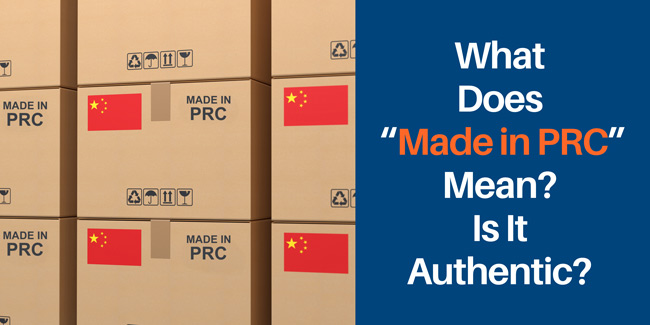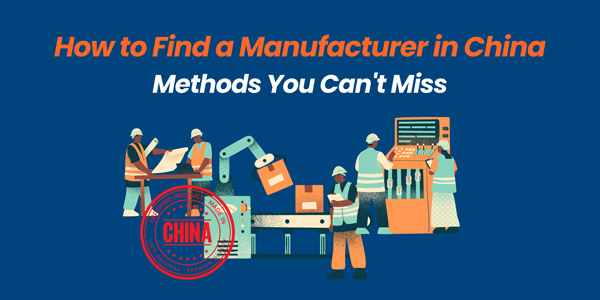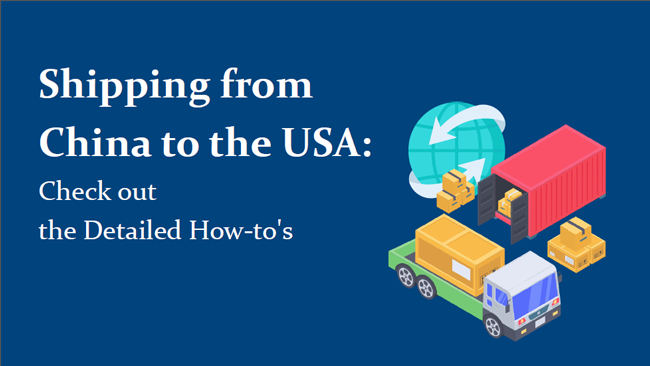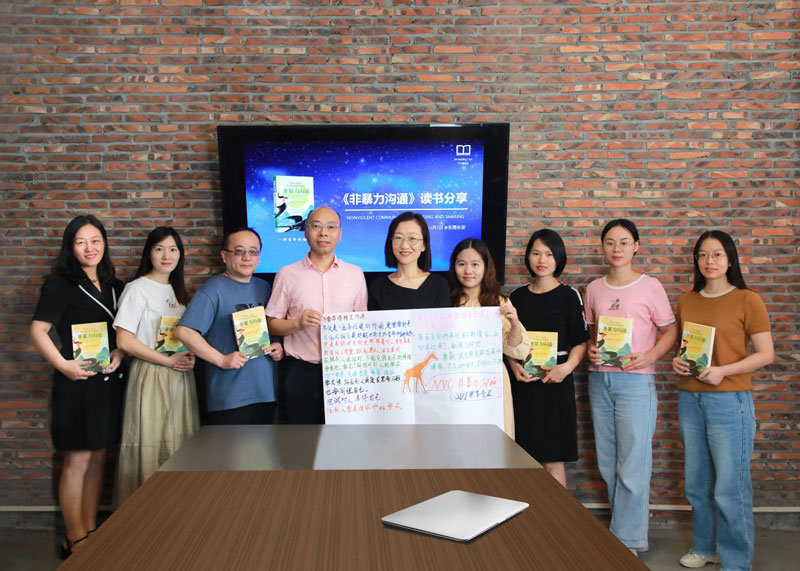What Does "Made in PRC" Mean? Is It Authentic?
- Date:
- Author: SVI Content Team
- Share:
Have you seen products labeled with the three letters “Made in PRC” in the stores? It could be new to you. This label is a common point of confusion for overseas importers.
As a consumer, you may wonder “What is Made in PRC?” and “Where is Made in PRC?”
However, as an importer, misunderstanding this label can lead to compliance issues, customs delays, or even penalties.
In this guide, we’ll cut through the ambiguity, learning what it means, why it is used, the legal and compliance risks you must know, and tips to verify your product’s quality.
Part 1. What Does "Made in PRC" Mean?
1. Immediate Definition
The “PRC” or “P.R.C.” stands for “People’s Republic of China,” the country’s official name.
Made in PRC = product manufactured in the People’s Republic of China.
Made in P.R.C. vs. Made in China: Is it the same?
Yes. The label “Made in” refers to the country of origin marking. So, when you see “Made in PRC”, it refers to the same country as “Made in China.” There is no difference in origin, manufacturing standards, or legal meaning between the two.
“Made in China” is more commonly seen on the labels of daily commodities and has a high global recognition rate.
While “Made in PRC” is often used to emphasize sovereignty or export to some countries sensitive to certain country names.
2. Why do some factories use the “PRC” label instead of “China”?
The appearance of “Made in PRC” first emerged around several decades and has become more common among consumers since the 2020s.
The shift from “Made in China” to “Made in PRC” is intentional and can be explained by a few reasons:
1) Attempt to avoid bias.
For years, some markets have linked “Made in China” with lower-quality goods, even though this perception is outdated and inaccurate.
By using “PRC”, manufacturers aim to present a fresh and neutral label that avoids preconceived bias and shifts attention toward product quality rather than the country name itself.
2) New brand positioning.
Many companies choose the “Made in PRC” label based on their target market and branding strategy.
It allows them to leverage a new perception of the label that resonates better with overseas consumers.
This helps them to reshape the brand, gain orders, and position Chinese-made products as modern, high-quality, and globally competitive.
3) Suppliers prefer the official name.
“People’s Republic of China” is the official, internationally recognized name of China in trade and diplomatic contexts. Some suppliers choose to use “PRC” because it appears more professional.
Part 2. Legal Requirements for Importers
1. Is “Made in PRC” legal to use?
Country of origin marking rules differ by destination. In most countries, there are no specific restrictions. In some countries, like the United States explicitly state the acceptable name for origin marking. Before sourcing from China, it is the safest practice to understand your local requirements or use the most recognized label in the packaging.
📌 United States:
The abbreviation “PRC” is not acceptable by U.S. Customs and Border Protection (CBP); only “China” or “P.R. China” is allowed, since these unmistakably identify the country for U.S. consumers.
📌 European Union:
Origin marking is not mandatory for most non-food industrial products such as electronics, apparel, and toys. However, it is required for specific categories like foodstuffs and cosmetics, where origin directly affects consumer safety, quality, or perception.
The label is allowed but optional for most products. It’s more important to ensure that your customs declaration correctly lists the origin as China (or People’s Republic of China) and that your product label is accurate and not misleading to consumers.
“Made in PRC” is generally not considered misleading, although “Made in China” is the most widely understood term.
📌 United Kingdom:
The United Kingdom follows a framework similar to the E.U. regarding country-of-origin labeling.
For most non-food manufactured goods, origin marking is not mandatory.
For certain regulated categories like food, cosmetics, and products covered by specific safety regulations, a label is required.
The key requirement is that the country of origin declared on the customs document (import declaration) must be correct (China), and any labels used must be clear, genuine, and not mislead consumers.
Example: If an item label features the Italian flag, the Eiffel Tower, or another clear national symbol, but the food was manufactured in China, the label must include a statement of the actual country of origin to prevent deception.
Acceptable Name for Country of Origin Marking
| Destination | Compliant Abbr. | Not Compliant Abbr. | Product Scope Required Origin Marking | Sources |
|---|---|---|---|---|
| United States | China P.R. China | PRC P.R.C. | ✔ All imported products | CBP rulings USDA AMS guidance |
| European Union | China P.R. China P.R.C PRC | / | ✔ Non-food manufactured goods, not mandatory; ✔ Certain regulated categories, mandatory. | Delegated regulation – 2015/2446 – EN – EUR-Lex |
| United Kingdom | China P.R. China P.R.C PRC | / | ✔ Non-food manufactured goods, not mandatory; ✔ Certain regulated categories, mandatory. | Customs declarations, duties and tariffs (import and export) |
2. What If I Get the Origin Marking Wrong
The CBP Rule states that all imported products must be clearly marked with the English name of their country of origin.
If the marking is incorrect or missing, the importer is responsible for correcting it under CBP supervision. Failing to comply can lead to several consequences:
1) Shipment Delay and Detention:
CBP may hold your shipment at the port of entry until the marking is corrected. This can cause delays and extra storage fees.
2) Mandatory Relabeling:
Generally, you are required to re-mark articles correctly under CBP supervision before release to avoid penalties.
- At port: Correct markings (via relabeling or re-stamping) while goods remain at the entry port.
- In bonded areas: Goods may be transferred to a bonded warehouse for relabeling with CBP approval.
3) Seizure or Forfeiture:
If labeling issues are not resolved, or if intentional mislabeling is found, the goods may be seized and forfeited, eventually destroyed, or auctioned.
4) Additional Duties:
Improperly marked goods that are released without correction may be charged a special 10% ad valorem marking duty.
This duty is based on the value of the goods and assessed in addition to any regular duties already applicable to the commodity.
5) Refused Entry:
If the incorrect labeling cannot be fixed promptly, the shipment could be denied entry and returned to the country of origin or redirected elsewhere.
FAQ about the Term "Made in PRC":
Q1. Is “Made in PRC” good?
Whether “Made in PRC” or “Made in China”, both labels indicate the location where products are grown or manufactured, not an indicator of quality.
Companies using the “Made in PRC” show that they are good at finding ways in marketing, trying new things. That’s where people may assume an innovative company (higher quality) will do.
The label on the box is not the determinant of product quality. An item with good quality is more affected by a factory’s manufacturing standards, materials, and the robustness of production management and quality control inspection.
Q2. Can I use “Made in PRC” for U.S. imports?
No, products imported into the United States cannot be labeled “Made in PRC.”
U.S. CBP regulations specifically require that the country of origin be marked in clear, complete English. Abbreviations that clearly indicate the country, like “P.R.China” is acceptable, while “PRC” or “P.R.C.” are some can lead to confusion, which is not under choice.
Q3. Can I use “Made in Hong Kong” if made there?
Effective since late 2020, CBP requires these goods to be marked as having their origin in “China” when imported into the U.S. for purposes of the U.S. marking statute (19 U.S.C. § 1304).
Q4. If parts made in multiple countries and final assembly in China, which country to label?
According to U.S. CBP under 19 CFR Part 177, an item is a product of a country or instrumentality only under the following circumstances:
(1) it is wholly the growth, product, or manufacture of that country or instrumentality, or
(2) in the case of an article which consists in whole or in part of materials from another country or instrumentality, it has been substantially transformed into a new and different article of commerce with a name, character, or use distinct from that of the article or articles from which it was so transformed.
Based on its definition, if parts are made in multiple countries and the final assembly is in China, the country to label is determined by the “substantial transformation” test.
a. If the final assembly in China constitutes “substantial transformation”, then the country of origin to label would be “China.”
b. If the assembly doesn’t substantially transform the product, only lightly assembled or packaged in China without creating a new product, the label may use the phrase “Assembled in China.”
c. Furthermore, if you want to indicate component sources, the phrase “Assembled in” can be written as “Assembled in China from components of (Country A, B, C).”
📑 Example:
The components (e.g., chips from the U.S. and a screen from Japan, a battery from Korea) are assembled, programmed, tested, and packaged in China. These turn into a laptop (a new and functional article) with a different name, character, and use.
Since the assembly process creates a new finished good, China is the true country of origin.
How to Verify Product Quality Beyond "Made in China" Label
It’s common for some buyers to assume that “Made in China” means lower quality, while “Made in P.R.C.” sounds more premium or neutral.
In reality, both labels refer to the same country, and product quality depends far more on the manufacturer’s capabilities and your quality control process than the label itself.
Here’s how importers can assess quality objectively, regardless of where it’s made:
For Importers:
- Request and review samples:
Ask for product samples before confirming the order. It helps examine the quality, material, and specification of real products. You can find out the issues before production.
- Secure and validate a signed golden sample:
Determine the physical standards and set a pre-production/golden sample signed and approved by both parties. This helps the inspector to compare random units from the production run directly against this sample.
- Check test reports and certifications:
Ask for up-to-date safety and performance reports (e.g., CE, ASTM, or CPSIA) that meet your target market’s compliance standards.
- Conduct factory audits:
Evaluate the supplier’s capabilities, quality control systems, equipment, management processes, and compliance before making an order.
- Set a clear quality control (QC) plan:
Define your quality standards, inspection criteria, acceptable quality limits (AQL), and testing requirements to avoid ambiguity.
- Implement rigorous final inspection:
Partner with a third-party inspection company or certified testing lab to verify the product’s quality and safety. Inspect packaging and labeling compliance before shipment.
SVI Global helps overseas importers ensure product quality and compliance in their target markets, from factory sourcing and audits to quality inspections and lab testing.
Your product’s true value goes beyond its label. Our Quality Assurance service helps channel the energy you might spend worrying about labels into vetting suppliers and enforcing quality checks. That is the strategy that protects your brand and ensures your imports meet the standards.
Need Help Sourcing from China?
Let SVI Global find the right suppliers and manage your imports with complete and error-free labels.
We guarantee quality and on-time delivery!
For Consumers:
- Read verified reviews:
Look for detailed feedback from real buyers on reputable platforms.
- Find and watch product test videos:
Independent reviewers often reveal actual performance, durability, or flaws for certain products.
- Purchase from well-known brands or retailers:
Choose sellers with strong reputations and reliable return policies.
- Inspect upon arrival:
Examine the product’s look, materials, and workmanship carefully. It’s a good idea to record the unboxing helps in case of returns.
- Test the product:
Ensure it works properly and safely right away.
- Check Instructions and Packaging:
Clear, fluent manuals and organized packaging often reflect that the brand cares about user experience.
Conclusion
“Made in PRC” means Made in the People’s Republic of China. The term may look new to some consumers, but it represents the same manufacturing origin as “Made in China.” Understanding the term can reshape perceptions and promote a more accurate view of Chinese manufacturing.
For businesses sourcing worldwide, however, the key lies not only in the wording but in compliance and accuracy. Different countries have specific rules for country-of-origin labeling, and importers must follow them carefully to avoid shipment delays or penalties.







